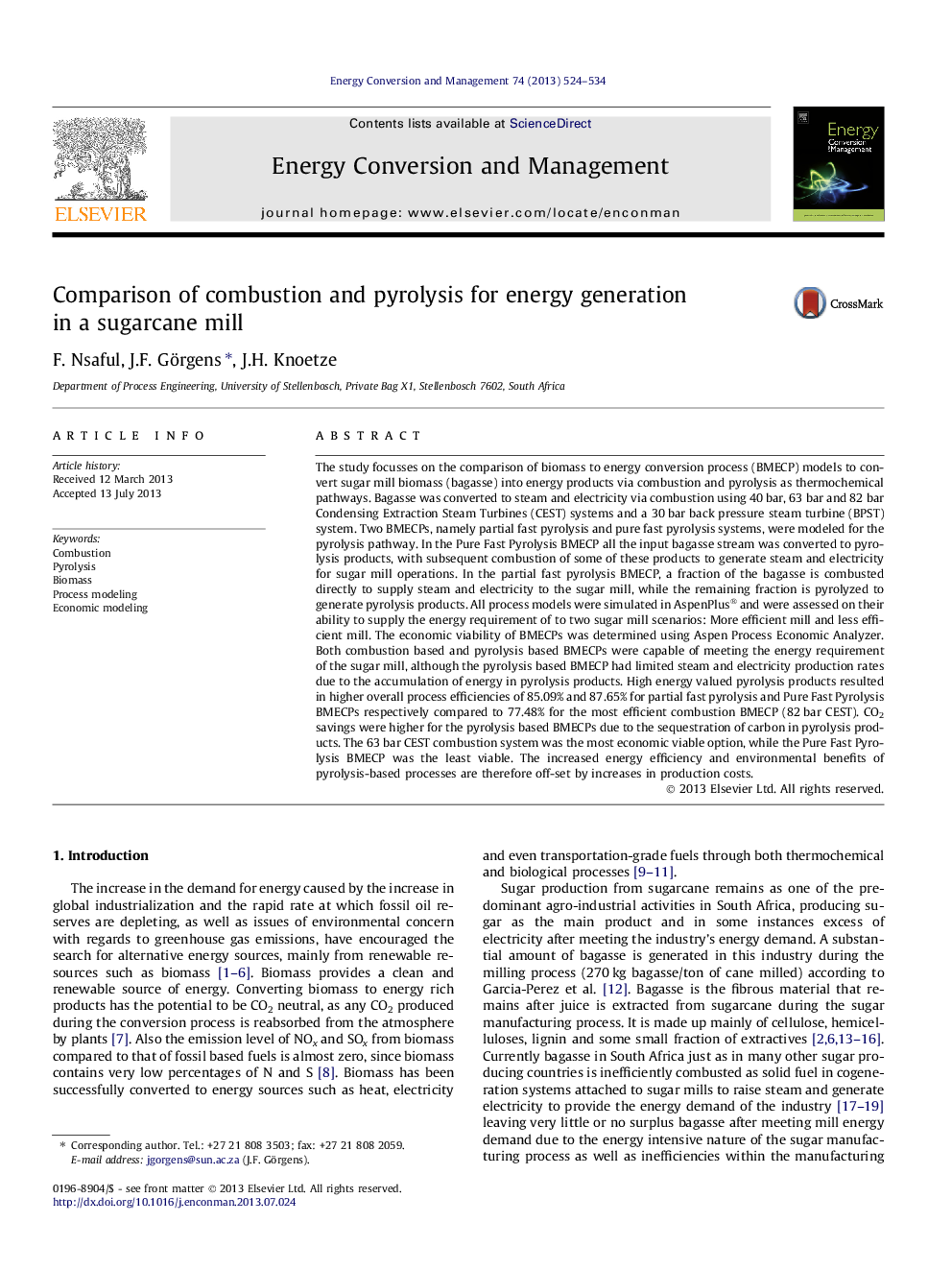| کد مقاله | کد نشریه | سال انتشار | مقاله انگلیسی | نسخه تمام متن |
|---|---|---|---|---|
| 7166891 | 1462888 | 2013 | 11 صفحه PDF | دانلود رایگان |
عنوان انگلیسی مقاله ISI
Comparison of combustion and pyrolysis for energy generation in a sugarcane mill
ترجمه فارسی عنوان
مقایسه احتراق و پیلوریس برای تولید انرژی در یک آسیاب قند
دانلود مقاله + سفارش ترجمه
دانلود مقاله ISI انگلیسی
رایگان برای ایرانیان
کلمات کلیدی
احتراق پیرولیز، زیست توده، مدل سازی فرآیند، مدل سازی اقتصادی،
موضوعات مرتبط
مهندسی و علوم پایه
مهندسی انرژی
انرژی (عمومی)
چکیده انگلیسی
The study focusses on the comparison of biomass to energy conversion process (BMECP) models to convert sugar mill biomass (bagasse) into energy products via combustion and pyrolysis as thermochemical pathways. Bagasse was converted to steam and electricity via combustion using 40Â bar, 63Â bar and 82Â bar Condensing Extraction Steam Turbines (CEST) systems and a 30Â bar back pressure steam turbine (BPST) system. Two BMECPs, namely partial fast pyrolysis and pure fast pyrolysis systems, were modeled for the pyrolysis pathway. In the Pure Fast Pyrolysis BMECP all the input bagasse stream was converted to pyrolysis products, with subsequent combustion of some of these products to generate steam and electricity for sugar mill operations. In the partial fast pyrolysis BMECP, a fraction of the bagasse is combusted directly to supply steam and electricity to the sugar mill, while the remaining fraction is pyrolyzed to generate pyrolysis products. All process models were simulated in AspenPlus® and were assessed on their ability to supply the energy requirement of to two sugar mill scenarios: More efficient mill and less efficient mill. The economic viability of BMECPs was determined using Aspen Process Economic Analyzer. Both combustion based and pyrolysis based BMECPs were capable of meeting the energy requirement of the sugar mill, although the pyrolysis based BMECP had limited steam and electricity production rates due to the accumulation of energy in pyrolysis products. High energy valued pyrolysis products resulted in higher overall process efficiencies of 85.09% and 87.65% for partial fast pyrolysis and Pure Fast Pyrolysis BMECPs respectively compared to 77.48% for the most efficient combustion BMECP (82Â bar CEST). CO2 savings were higher for the pyrolysis based BMECPs due to the sequestration of carbon in pyrolysis products. The 63Â bar CEST combustion system was the most economic viable option, while the Pure Fast Pyrolysis BMECP was the least viable. The increased energy efficiency and environmental benefits of pyrolysis-based processes are therefore off-set by increases in production costs.
ناشر
Database: Elsevier - ScienceDirect (ساینس دایرکت)
Journal: Energy Conversion and Management - Volume 74, October 2013, Pages 524-534
Journal: Energy Conversion and Management - Volume 74, October 2013, Pages 524-534
نویسندگان
F. Nsaful, J.F. Görgens, J.H. Knoetze,
